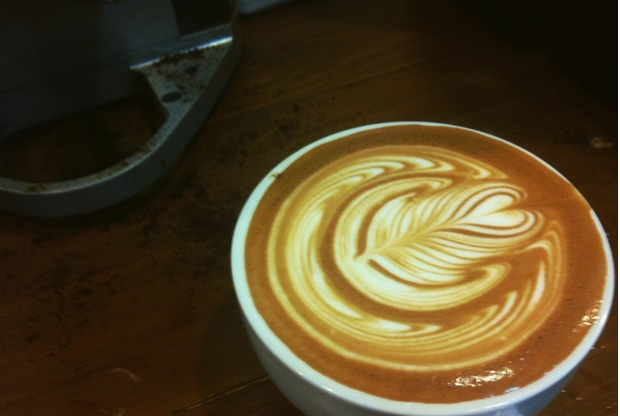Learning Coffee Theory: how to identify espresso correctly
Follow the caf é (Wechat official account vdailycom) and found that Beautiful Cafe opened a small shop of its own.
Espresso is an Italian word that means on the spur of the moment and "for you" (cooked right away for you).
Espresso was born in 1946, and Gaggia further improved the piston pressure system-using spring pressure instead of manual pressing-to float a golden layer of coffee fat on brewed coffee-Crema Klima, the first appearance of Crema Clema in coffee history, and this year became the official birth year of Espresso.
Gaggia officially established the coffee machine factory in 1948, and the mass-produced Gaggia coffee machine was sought after by the major cafes in Italy at that time, which accelerated the popularity of Espresso in Italy, Spain, Portugal and other southern European countries.
But it wasn't until around 1986 that Espresso was introduced around the world by Starbucks. Since then, people in the coffee industry around the world began to know and understand this kind of coffee. It was only about a decade earlier than the Chinese people came into contact with espresso. So the more popular and reasonable way to name it is espresso.

"Espresso" is known as the "soul of coffee", but it should not be translated as "espresso" in Chinese, because in addition, there is a stronger coffee that needs to be used. For cafes, "a coffee shop that does not sell 'Espresso' is not a coffee shop", which shows the importance of "Espresso".
Now "Espresso" has almost become a representative symbol of Italy, so it seems more natural for Italy to define "Espresso".
So what is "Espresso"?
Comprehensive coffee beans roasted at a depth of 7-8 grams are ground into very fine coffee powder. after 9 atmospheric pressure and high temperature hot water of about 92 degrees Celsius, 30 milliliters of strong coffee liquid is rapidly extracted in a short time of 15 seconds called "Espresso".
Espresso is a technological way of making coffee. According to the definition of "EspressoCoffee The Chemistry of Quality", it must meet the following conditions:
The weight of coffee powder (one cup) 6.5 ±1.58g
Temperature of water (℃) 90 °±5 °
Water pressure 9 ±2 Atmospheric pressure (bar)
Filtration time 30 ±5 seconds
The temperature of water
If the water temperature is too low, it will cause insufficient extraction, and the substances inside the coffee can not be fully released, so that you can only cook a cup of Espresso; with insufficient flavor and sour taste. Once the water temperature is too high, excessive extraction will make the coffee bitter and astringent.
The pressure of water
The general hot water brewing method can only extract water-soluble substances in coffee, while Espresso can further extract water-insoluble substances under high pressure. These high pressures will completely emulsify the lipids (Lipophilic Substances) inside the coffee and dissolve into the water, which is the main source of "mellow taste" (body).
Emulsification will make Espresso taste thicker, making people drink with a "velvety" feeling; and stickiness will form a lower surface tension, more able to invade the taste buds, so that mellow reverberate in the mouth for a long time.
Filter time
The length of filtration time will affect the amount of water output. Espresso uses high-pressure hot water to extract the flavor of the coffee, which takes about 25 seconds to complete the task (after this time, the liquid is no longer tasty and will only dilute the Espresso). After the timeout, some people continue to let it out of the water and fill a cup to form a "Americano" or "Lungo", which tastes like charcoal-roasted coffee.
The most important thing about a successful "Espresso" is to see if there is a thick layer of brown-red grease foam floating on the surface: "Crema Cleima".
The most important feature of "Espresso" is the cohesion of fragrance and taste. The general orthodox way to drink is to drink it in one sip while waiting for the coffee to come out. While enjoying the fragrant taste, caffeine intake is greatly reduced. This drinking method, which takes the taste of coffee to the extreme but takes care of health, has made coffee experts around the world recognize that "Espresso" is worthy of the soul of coffee.
Espresso is Italian, meaning "under pressure", which reflects the importance of stress in the production of espresso. In the eyes of those who play with coffee, Espresso is no longer a simple "espresso". It is a kind of comprehensive coffee, a method of roasting, a kind of coffee brewing, a kind of cooking, but also a kind of life.
Common mistakes
Excessive extraction
Too much coffee powder
Too fine powder
The temperature is too high.
After coffee extraction, the temperature is too low.
The coffee cup is too cold
The handle temperature is not enough.
Coffee powder is too fine
Insufficient extraction.
Insufficient extraction, single color and insufficient concentration
There is not enough coffee
The coffee powder is too coarse
Pressure is too low
The coffee machine is not warm enough.
The coffee cup precipitated too much after drinking.
Excessive water pressure
The strainer is worn out.
There is stagnant water on the handle after extraction
The water temperature is too high
Insufficient amount of powder
The powder is too fine
Drain valve malfunction.
Important Notice :
前街咖啡 FrontStreet Coffee has moved to new addredd:
FrontStreet Coffee Address: 315,Donghua East Road,GuangZhou
Tel:020 38364473
- Prev

The skill of coffee flower drawing: the fluidity of liquid surface during flower drawing.
Follow the comments (Wechat official account vdailycom) found that the beautiful cafe opened a small shop of its own, integration is a crucial link in the coffee flower, like building and laying the foundation, there are two points to think about the state of integration: one. The second method of integration. There are thousands of ways to fuse liquids, including spinning in circles, sloshing around, and fixed-point injection.
- Next

What are the responsibilities of baristas? what are the contents of baristas' work?
Following Cafe Review (official Wechat account vdailycom) found that Beautiful Cafe opened a small shop of its own barista responsibilities: direct superiors: the foreman's scope of work: 1, dress in accordance with the regulations, keep clean and tidy, observe working hours, and obey the command and management of superiors. 2. Do a good job in the environmental hygiene of the assigned area so that you can make all preparations for work. 3. Practice skills diligently and have rich skills.
Related
- What is the meaning of lactic acid fermentation with coffee bean treatment?
- How to judge the state of foam by sound?
- How does the latte pull out the unicorn pattern? Come to get for a little trick to improve the flower pull!
- Will flower pulling affect the taste of the latte?
- Do you know the history of coffee?
- The difference between honey treatment and sun washing what is raisin honey treatment?
- What kind of milk can a novice use to make coffee foam to keep the foam longer? The correct method and skills of milking tutorial sharing
- Why do washed coffee beans taste sour? Flavor characteristics of washed Coffee
- Introduction to the skill of how to practice the size and height of water injection around the circle of hand-brewed coffee
- How do beginners practice coffee flower drawing from scratch?

